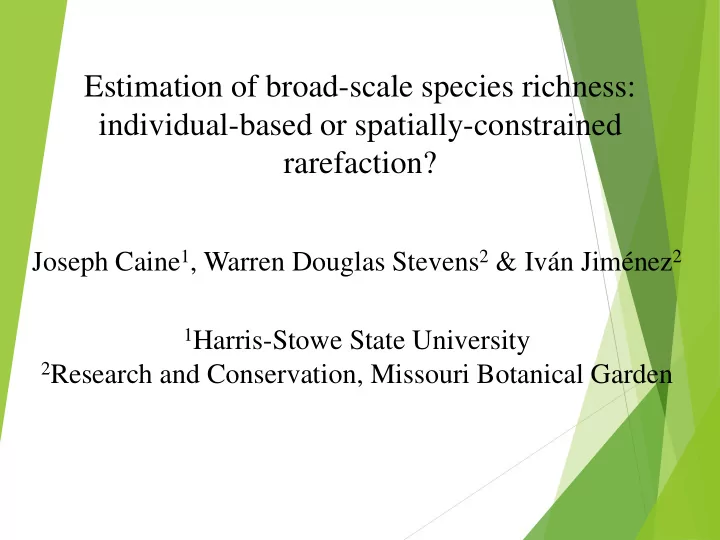

Estimation of broad-scale species richness: individual-based or spatially-constrained rarefaction? Joseph Caine 1 , Warren Douglas Stevens 2 & Iván Jiménez 2 1 Harris-Stowe State University 2 Research and Conservation, Missouri Botanical Garden
Vascular plant richness (Kreft and Jetz 2007)
The Wallacean shortfall: “paucity of information on the geographic variation of nature” (Lomolino et al. 2010) Alfred Russell Wallace and Henry Walter Bates hanging out in 1848 by Belém (Pará), Brazilian Amazonia.
Individual-based rarefaction The simplest rarefaction approach to estimate broad-scale species richness using data from natural history museum and herbarium specimens is known as individual-based rarefaction (Gotelli & Colwell 2001). Under this approach 𝐹 𝑇 𝑜 .is estimated from multiple random samples of n specimens drawn from the pool of N specimens collected in a sampling unit. Ideally, the pool of N specimens collected in a sampling unit would be a random sample from the (potentially very large) set of individuals occurring in the sampling unit.
Spatially-constrained rarefaction Spatially constrained rarefaction aims to control for the spatial arrangement of sampling activities across a sampling unit (Chiarucci et al. 2009, Bacaro et al. 2012). In spatially constrained rarefaction the spatial proximity of individuals is considered when drawing subsets of n individuals from the pool of all N individuals. In particular, these subsets are obtained by drawing individuals that are near each other in geographic space.
Research hypothesis : When estimating broad-scale species richness using data from natural history museum and herbarium specimens, spatially-constrained rarefaction is less biased than individual-based rarefaction, because it reduces over estimation of species richness due to spatial aggregation of sampling activities.
Definitions E[sn.r] E[Sn.scr] Sn.a
Study system and general methods - The Nicaragua flora - The flora of Nicaragua is highly diverse, for our study system we used the entire vascular plant flora which includes both woody and herbaceous species. - Data source and cleaning - Tropicos database - What was excluded for the data - The spatial scale and number of grid cells used - 5km x 5km grid cells - At lease 200 specimen records - How species richness was estimated - Use of accumulation curves - Individual rarefaction - Spatial constrained rarefaction
Prediction 1 on average, across grid cells, E[Snr] - Sna > 0 The first prediction states that, on average across grid cells, 𝐹 𝑇 𝑜.𝑠 is larger than 𝑇 𝑜.𝑏 . This prediction derives from the fact that accurate rarefaction curves are statistical expectations of accumulation curves (Gotelli & Colwell 2001).
Results of testing prediction 1
Prediction 2 The relationship between 𝑇 𝑜.𝑠 – 𝑇 𝑜.𝑏 and N – n is positive
Results of testing prediction 2
Prediction 3 𝐹 𝑇 𝑜.𝑠 – 𝐹 𝑇 𝑜.𝑡𝑑𝑠 > 0
Results of testing prediction 3
Prediction 4 The relationship between 𝐹 𝑇 𝑜.𝑠 – 𝐹 𝑇 𝑜.𝑡𝑑𝑠 and N – n is positive
Results of testing prediction 4
Prediction 5 | 𝐹 𝑇 𝑜.𝑡𝑑𝑠 – 𝑇 𝑜.𝑏 | – | 𝐹 𝑇 𝑜.𝑡𝑑𝑠 – 𝑇 𝑜.𝑏 | > 0
Results of testing prediction 5
Prediction 6 The| 𝐹 𝑇 𝑜.𝑡𝑑𝑠 – 𝑇 𝑜.𝑏 | – | 𝐹 𝑇 𝑜.𝑡𝑑𝑠 – 𝑇 𝑜.𝑏 | and N – n is e relationship between positive.
Results of testing prediction 6
Conclusions The hypothesis was not empirically supported. Broad-scale species richness estimates based on spatially-constrained rarefaction do not seem to be less biased that those based on individual-based rarefaction
Acknowledgements REU program, Missouri Botanical Garden, Warren Douglas Stevens & Iván Jiménez
Recommend
More recommend